You may not find this terribly rewarding unless you're included here, so this is a good time for casual and random browsers to turn back before they get too caught up in the sweep and majesty of the proceedings and can't let go.
It's a new day, and we're off to see Caravaggio's last painting, waiting for us somewhere along the Via Toledo. And after that, St Elmo's fortress!
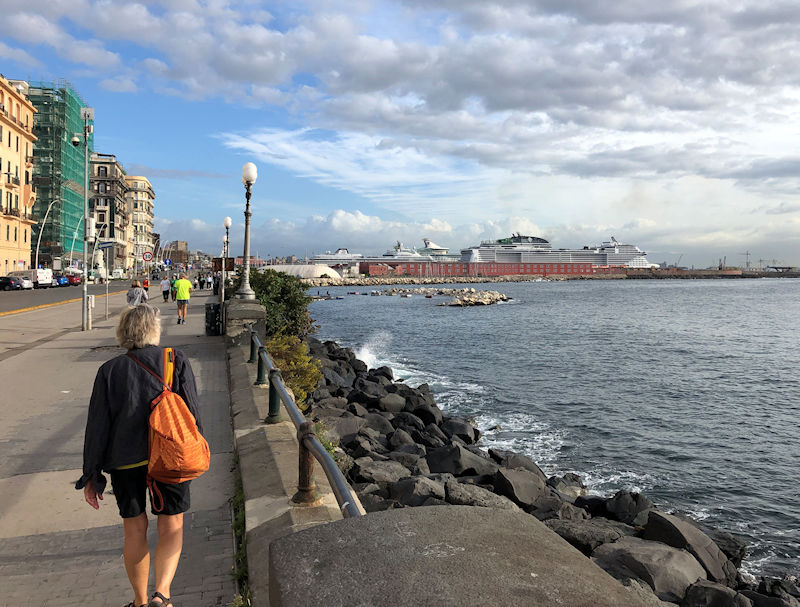
Along the Via Partenope / Via Nazario Sauro coast road on a bright and invigorating morning, with . . .
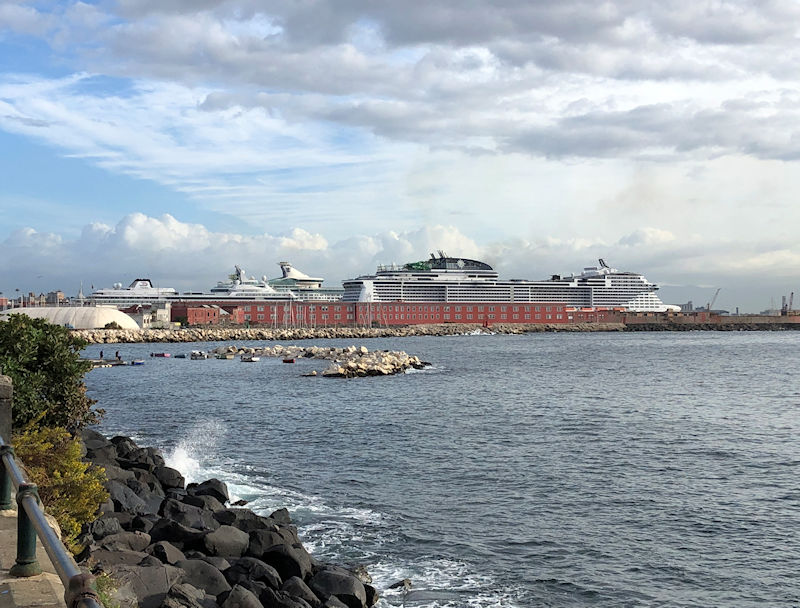
. . . a lovely vision of at least five monstrous cruise ships parked in the port. All disgorging passengers who will vie with us for room on the sidewalks. How unfair.
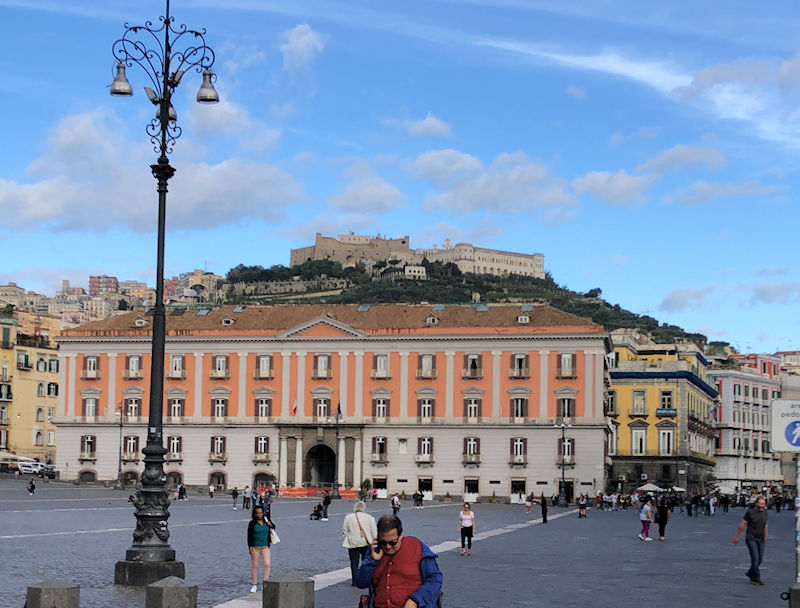
Across the Piazza del Plebiscito
(-- Hold on, Elmo. We're coming!)
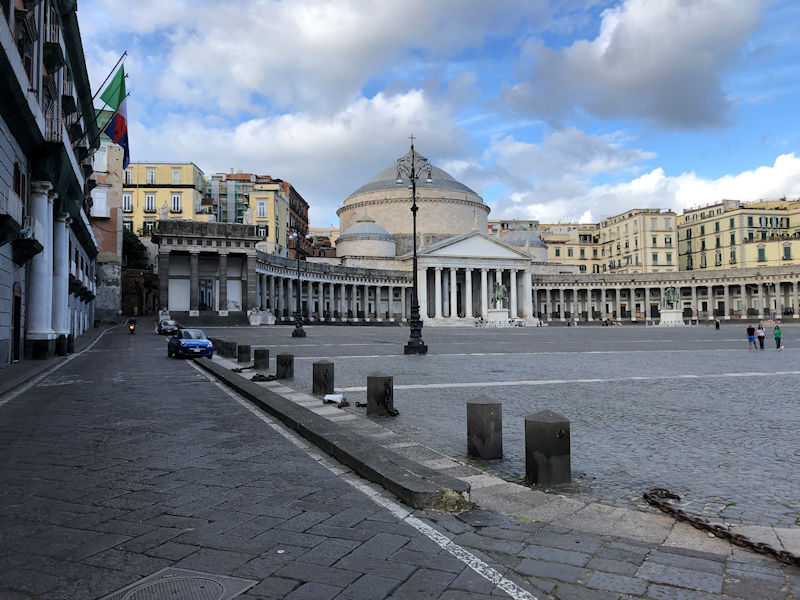
It's time to find out what that thing is all about.
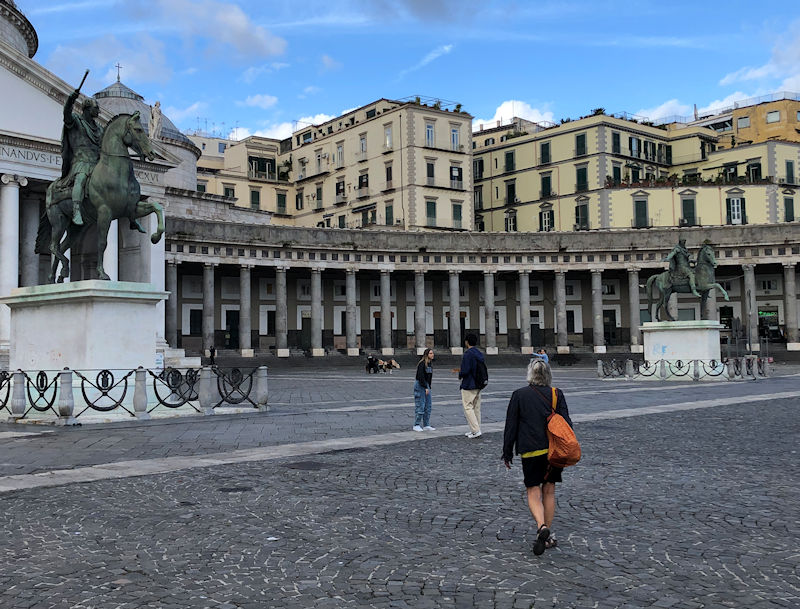
But first we have to get round these big equestrian things -- we've been informed that we've got Charles VII of Naples (King Charles III of Spain after 1759), on the left, and on the right his son Ferdinand IV of Naples (Ferdinand I as King of the Two Sicilies after 1816).
They were largely modeled by Antonio Canova, who'd contracted to make a statue of Napoleon and had to be coerced into changing the subjects. He died in 1822 before completing the Ferdinand rider, who was added by his pupil Antonio Cali. A mob almost destroyed the statues after Garibaldi's forces entered Naples in 1860, but they were dissuaded by a priest who promised to substitute Garibaldi's and Victor Emmanuel's heads later.
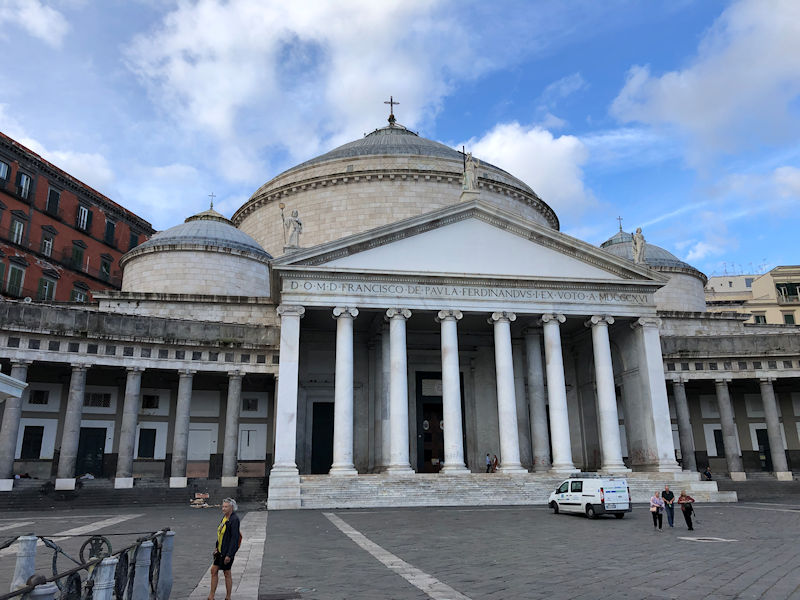
It is, as it turns out, the Basilica Reale Pontificia San Francesco da Paola. We're told that the Piazza del Plebiscito and the church were originally planned by Napoleon's brother-in-law, briefly the King of Naples Joachim Murat, but when the Bourbons were able to come back from exile, Ferdinand I continued the work but revised the plans and dedicated it to St Francis of Paola, since the saint had stayed for a time in a monastery on this site.
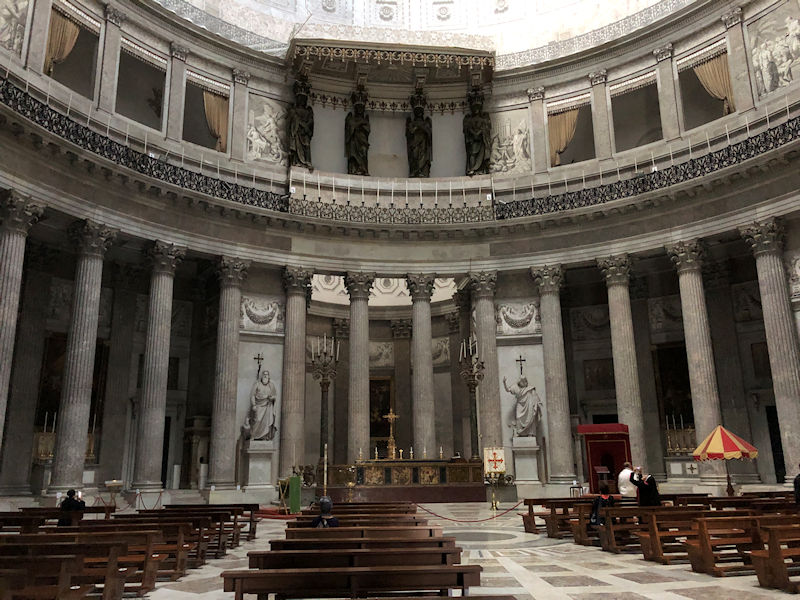
Somebody may have been thinking of the Pantheon in Rome as this was taking shape.
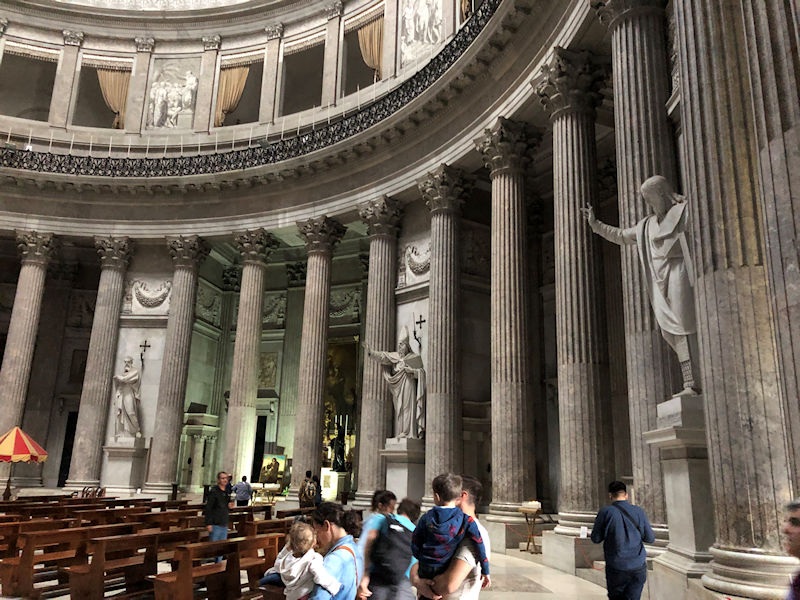
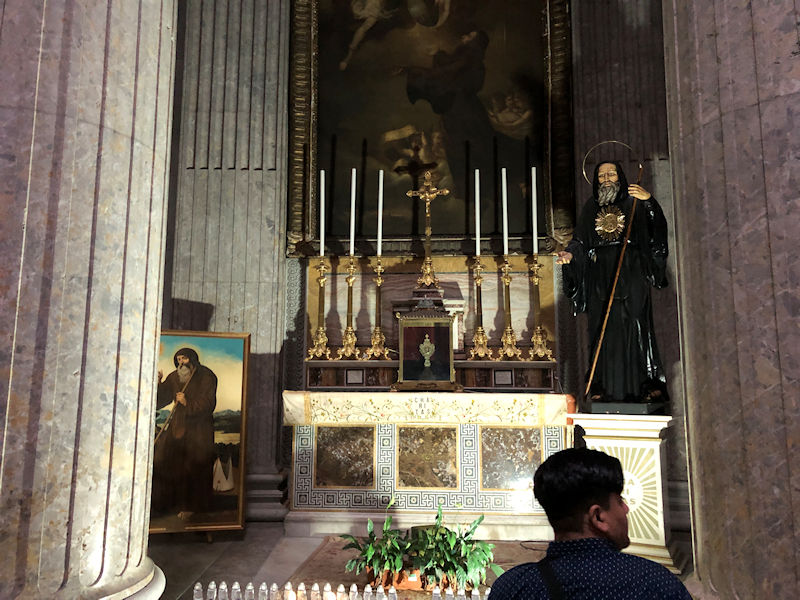
That Rasputin figure is evidently meant to be this St Francis, a 15th century kid from Paola in Calabria who got involved with Franciscans and became a hermit. Others had joined him by 1436, and by ca. 1454 they'd built a large monastery and founded the Hermits of St Francis of Assisi, later renamed the Order of the Minims by the popes who approved their monastic rules, because they emphasized humility. He and his followers cured lots of people in Italy and France, prophesied a great deal, and brought some dead people and animals back to life, and he died himself in France in 1507. He was canonized by Leo X in 1519.
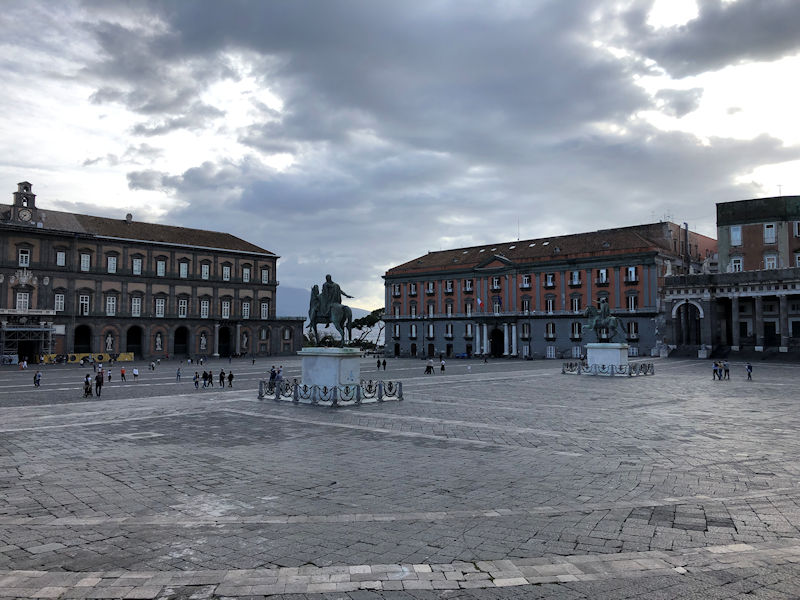
Out we get, evading the bronze horse fellows, anticipating a short delay to seek out a shoe repair shop
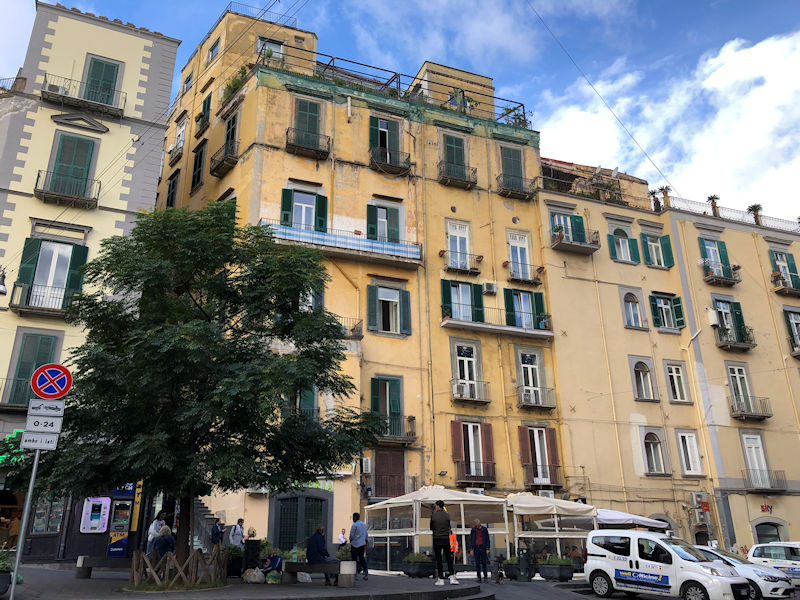
In about 1962, there was a hit song in the USA by the Drifters extolling the virtues of being 'Up On The Roof' in the city. These rooftop dwellers would doubtless understand.
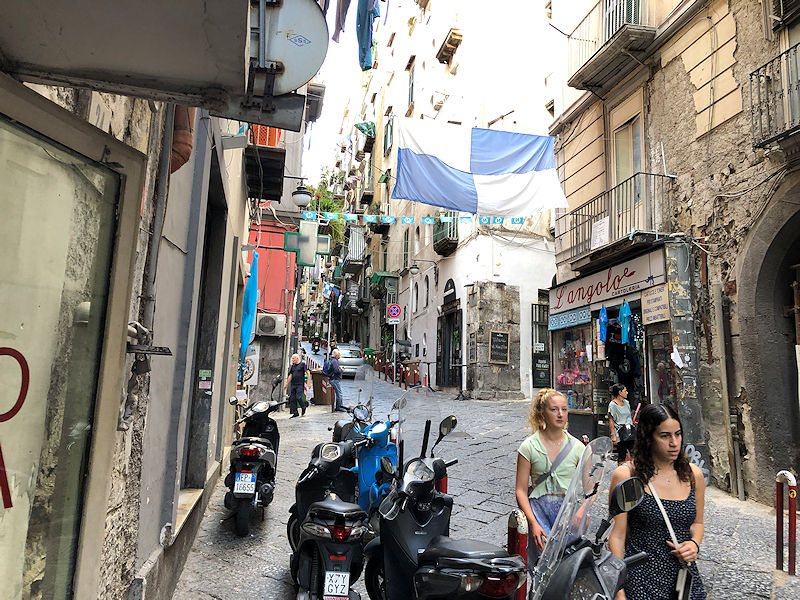
We're back on the Via Nardones, asking round about the . . .
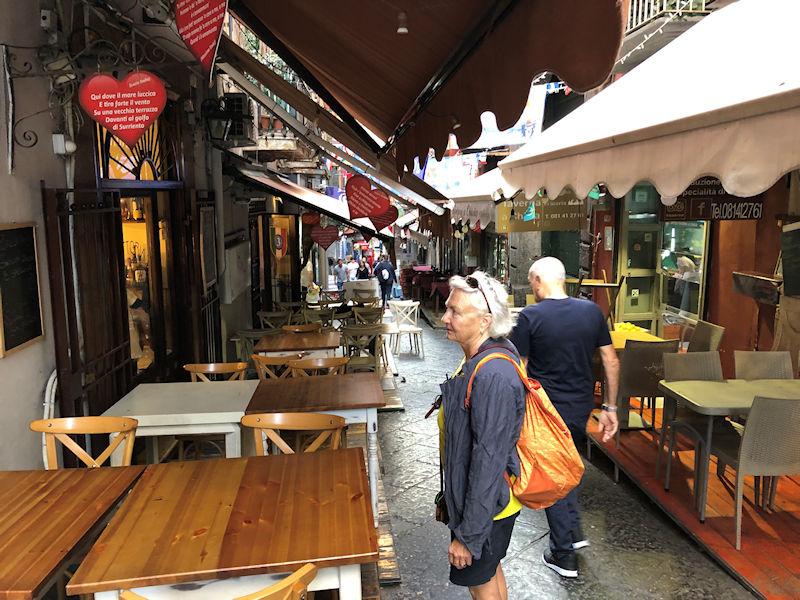
. . . shoe repair man. With a sack full of aging Italian shoes require professional assistance.
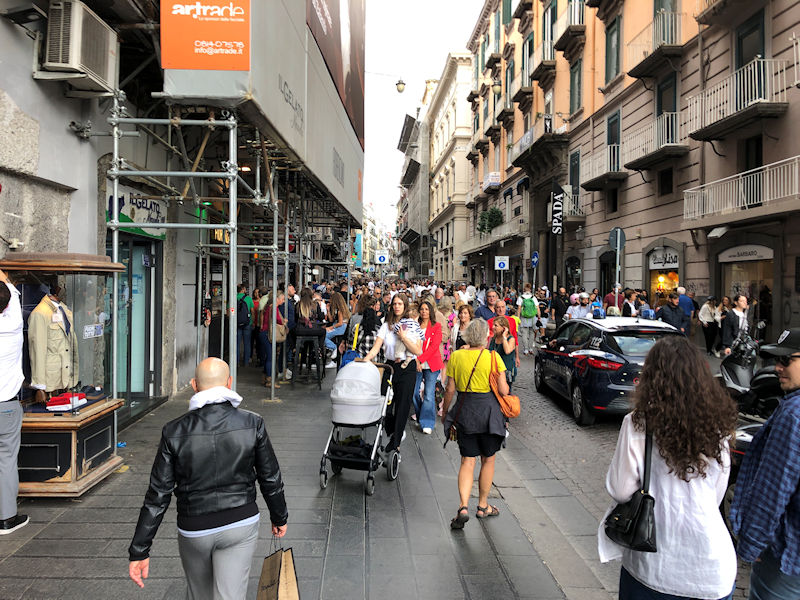
Found him. Empty sack now. We're looking for Caravaggio's last painting, which is . . .
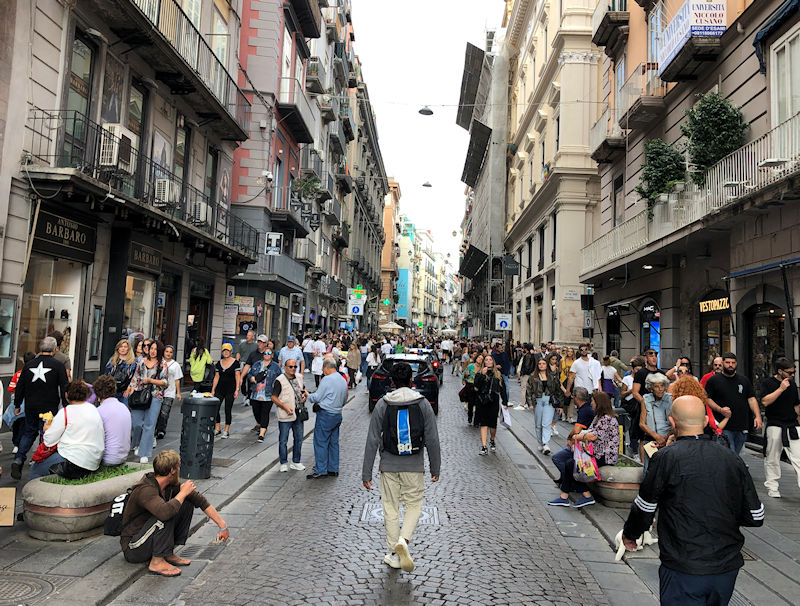
. . . somewhere along Via Toledo. In fact, about 350 meters up the road, we find . . .
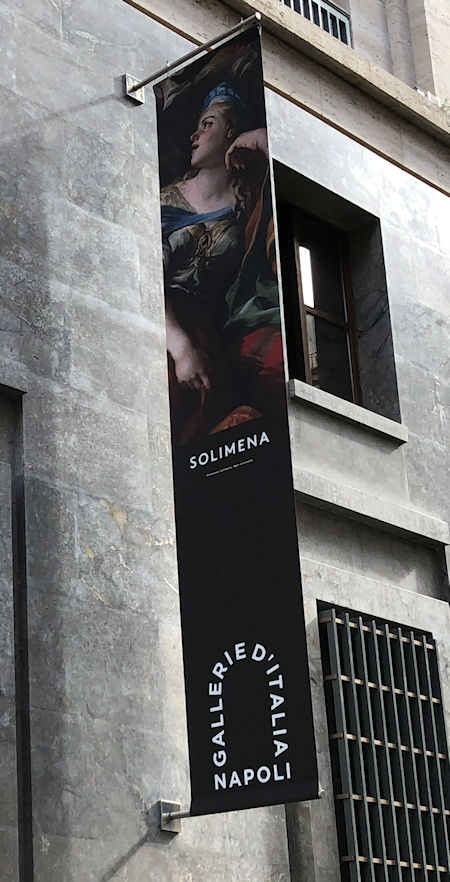
The Gallerie d'Italia - Napoli. Waiting for us.
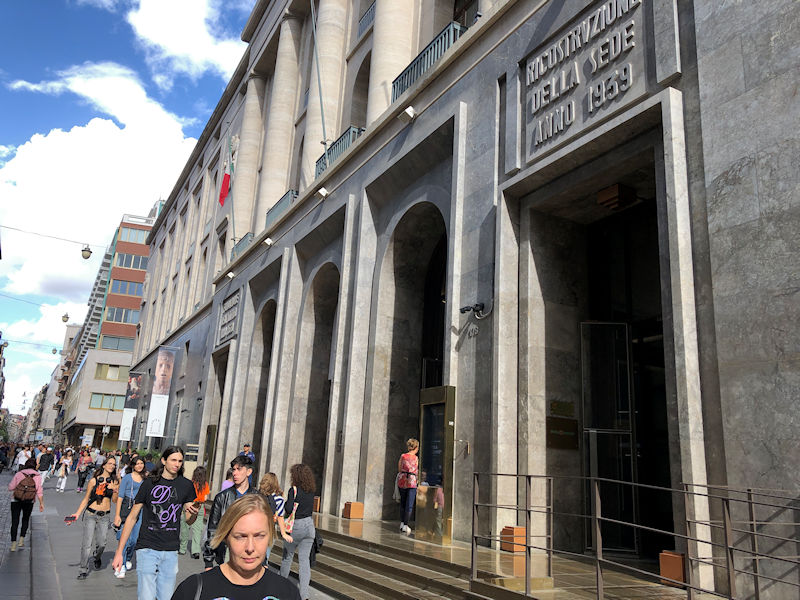
All those fine paintings and objets d'art hiding out in a Mussolini era fortress by the look of it. After a welcome little snack in the café inside, we're prepared for . . .
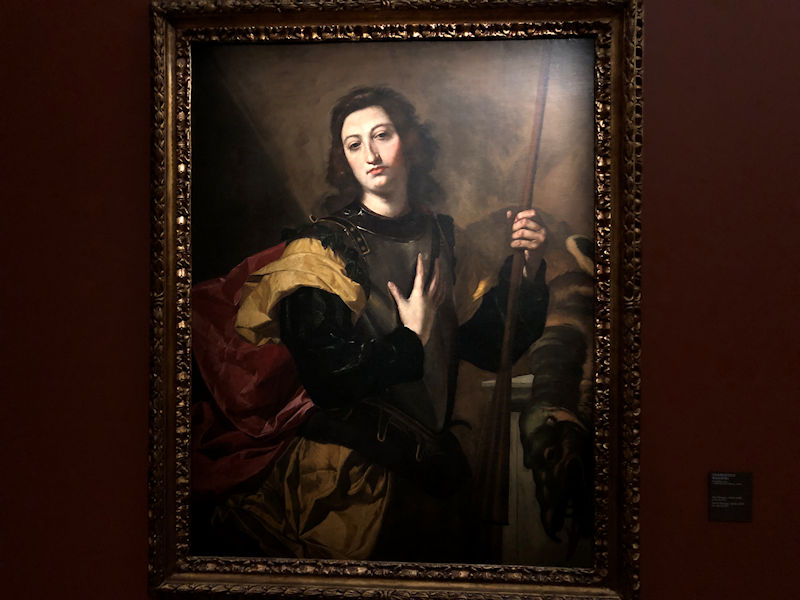
Caravaggio. Not a semi-effeminate St George the Dragon Slayer by Francesco Guarino.
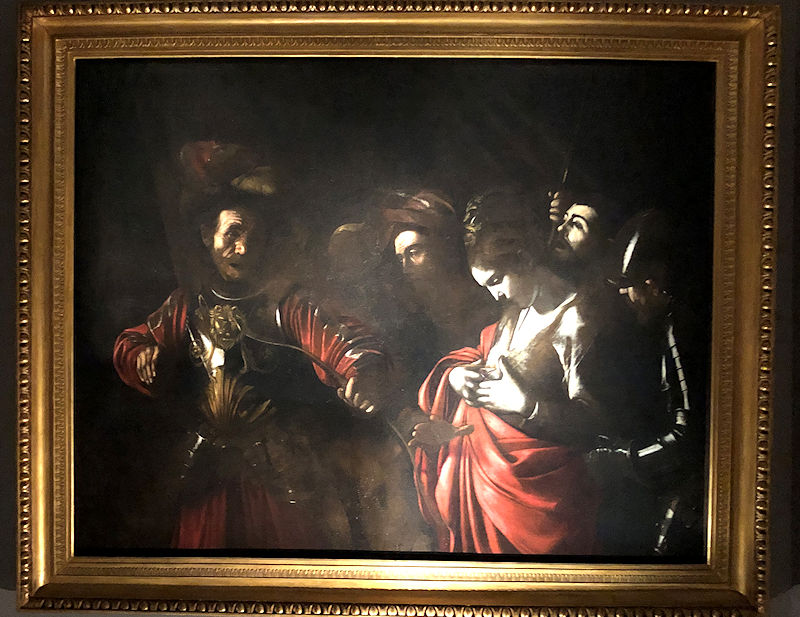
Here he is. The artist had arrived in Naples from Sicily in October 1609, but he'd been assaulted by four armed men and convalesced for a considerable period. On 11 May 1610, however, the agent in town for Marcantonio Doria of Genoa, a young nobleman who was a enthusiastic collector of Caravaggio's work, informed his boss that the painting was ready but needed just a quick touch-up. Doria received it in June.
St Ursula, according to gossip, set off with 11,000 virgin companions on a pilgrimage but were captured by Huns near Cologne. The King of the Huns had all the virgins slaughtered but fell for Ursula and insisted that she marry him. She said no, so he shot her with an arrow. The date of AD 383 has been mentioned in some versions. In Caravaggio's telling, he's just shot his arrow and Ursula is looking down with an 'Oh, what have you done now?' look on her face.
Shortly after this painting was delivered, the artist set off by ship in July to receive his papal pardon for have killed someone in a duel four years earlier, but died en route, mysteriously and controversially, but probably of a fever. There is some question of whether the upturned face behind Ursula is Caravaggio's own.
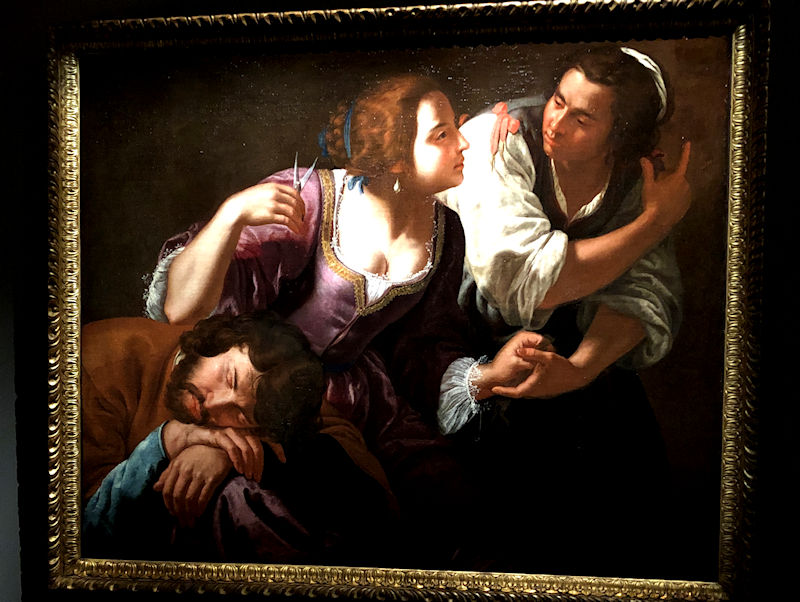
Our good fortune continues. Next to Caravaggio, one of our next most favorite artists is Artemisia Gentileschi, and here she is. Poor Samson is getting a haircut by the perfidious Delilah (dated 1630-1638).

Artemisia's most famous work is her Judith and Holofernes, but this isn't it. This is by the Flemish Ludovicus Finton or Finsonius (ca. 1580/85-1617), who worked in Naples from ca.1606 to ca.1613. It's not bad, though.

Another Judith and Holofernes, with a workmanlike Judith but less blood from Holofernes, by Biagio Manzoni, a Caravaggeschi from Faenza
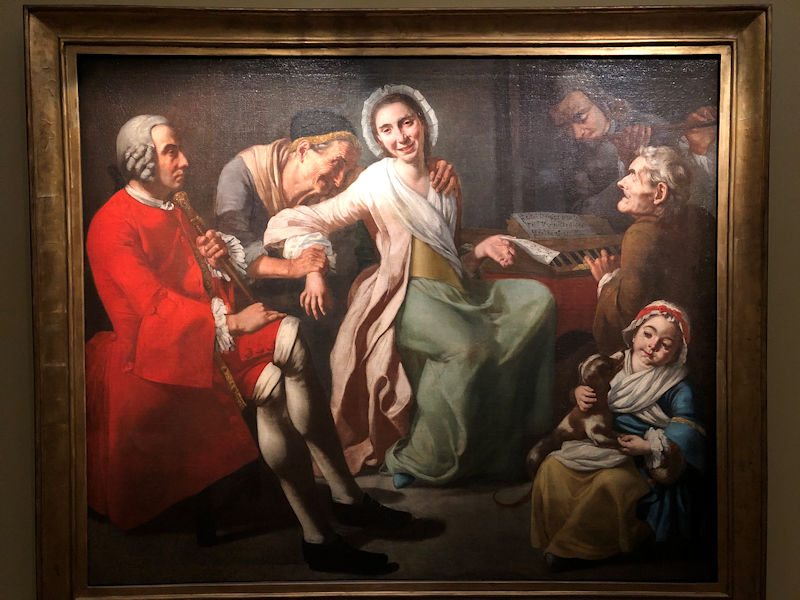
We missed the labeling for this but couldn't pass it up.
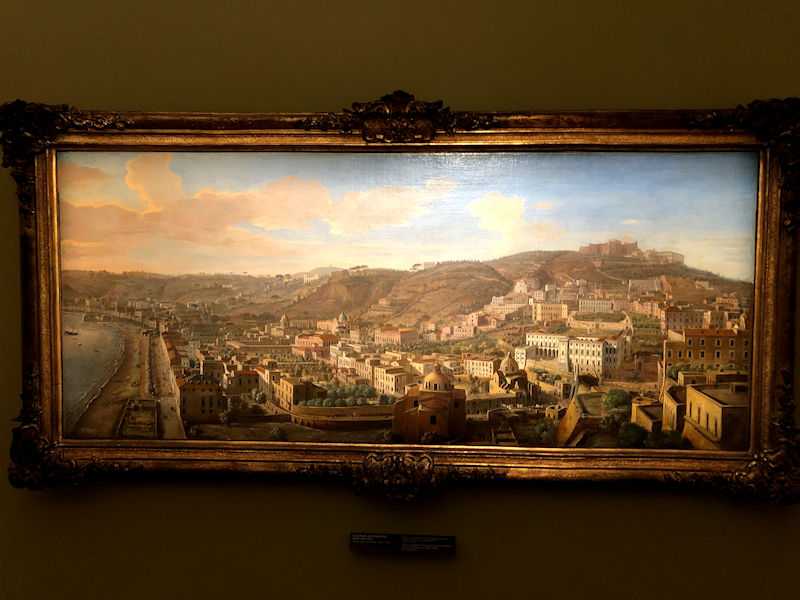
Two landscape views of Naples by the Dutchman known by several variants but mostly as Caspar van Wittel (ca.1652-1736), who moved to Italy in 1674 and stayed, mostly in Rome, but in many other locations as well, including Naples, until his death.
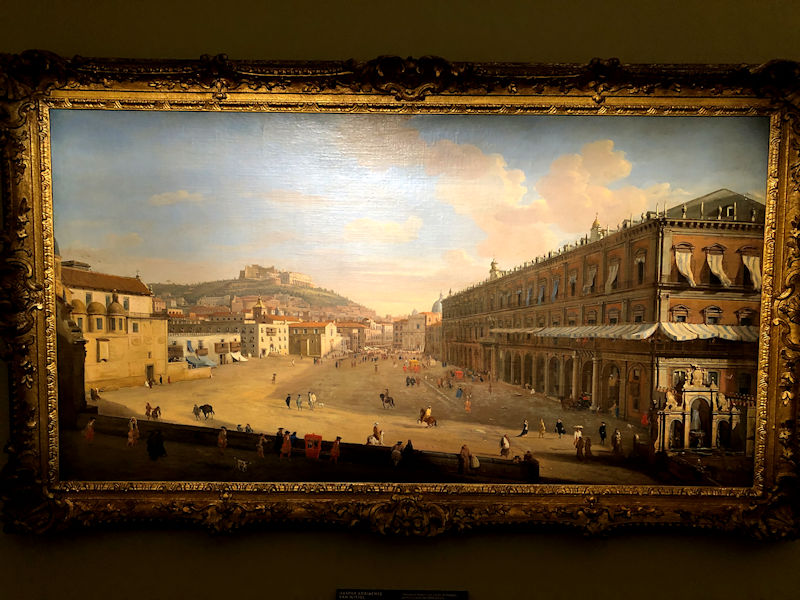
The present Piazza del Plebiscito, with the royal palace but no Pantheon knock-off for St Francis de Paolo. Van Wittel's said to have been one of the best-known painters in the vedute style: 'detailed and accurate recognizable city and landscapes that appealed to the sense of local pride of the wealthy Dutch middle class', and Neapolitan middle class it might be said as well.
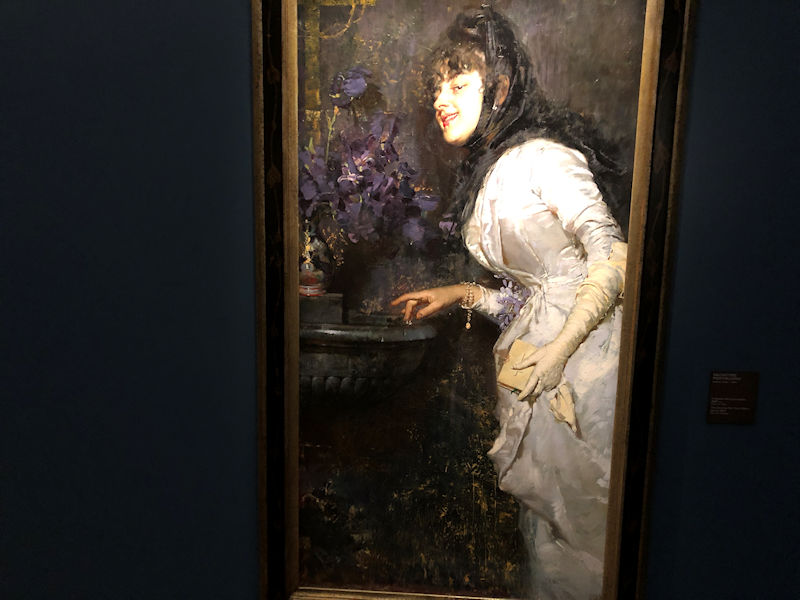
A grace note by Salvatore Postiglione (1861-1906) of Naples, called 'The Devil in the holy water'.
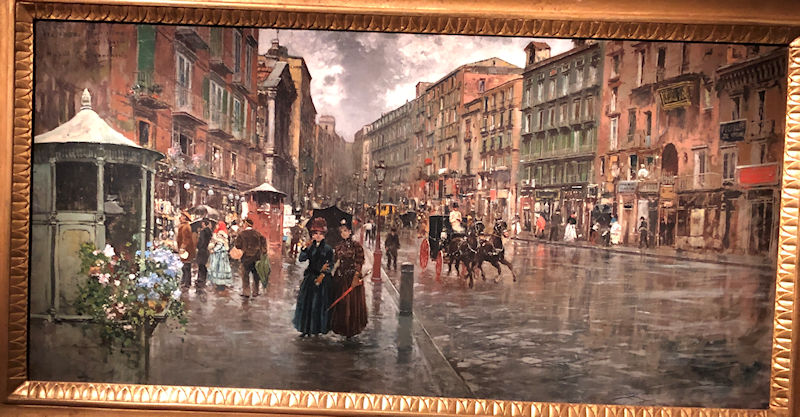
And here's a view of the Via Toledo back in the days before throngs of cruise shippies were even dreamt of, by Carlo Brancaccio (1861-1920), who specialized in city streets, sea- and landscapes, mostly vedute of Naples.
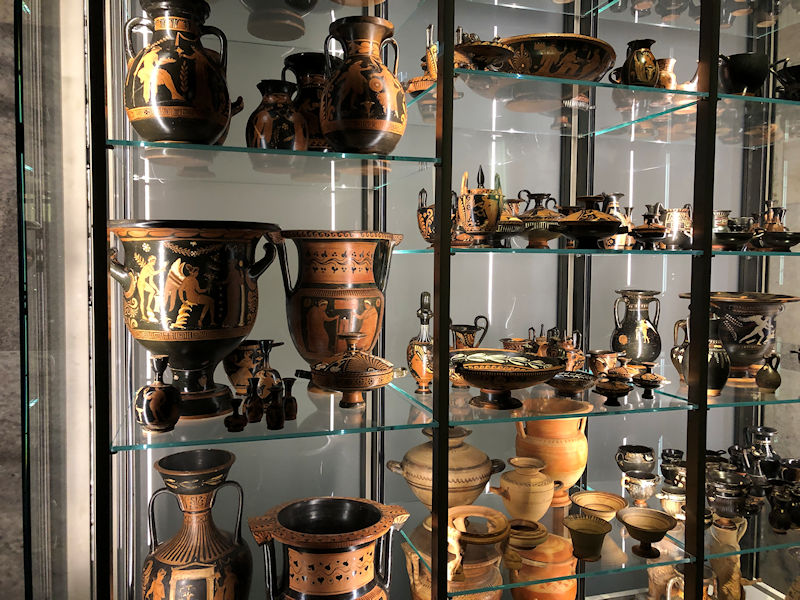
What Italian museum is complete without lots of . . .
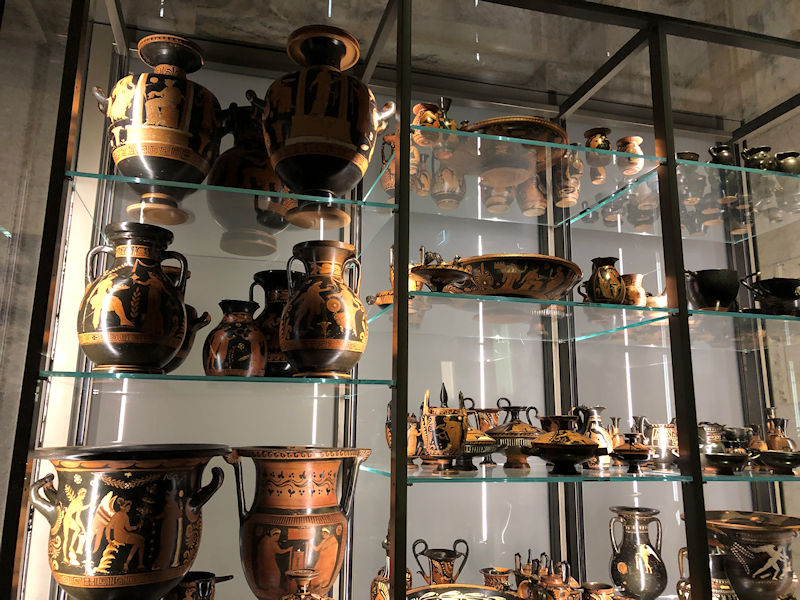
. . . classical vases, and similar Greek and Roman survivals, and . . .
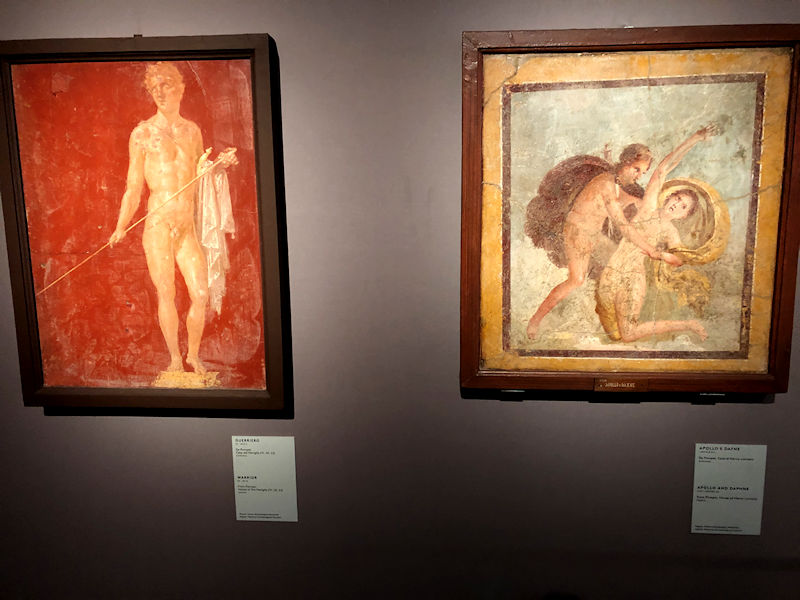
. . . frescoes from Pompeii, like this Warrior and Apollo and Daphne.
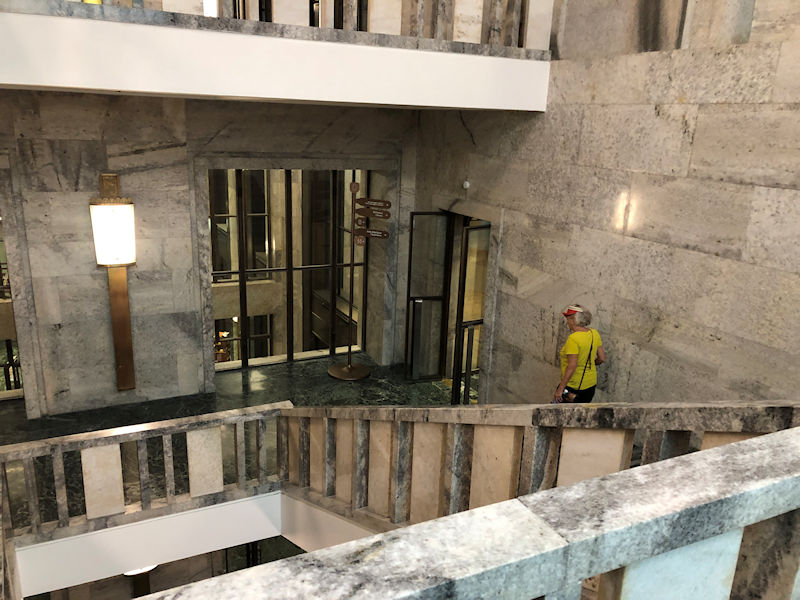
A lot of fun at this wonderful centre-city attraction, even it's built rather like a 1930s-era prison or something like.
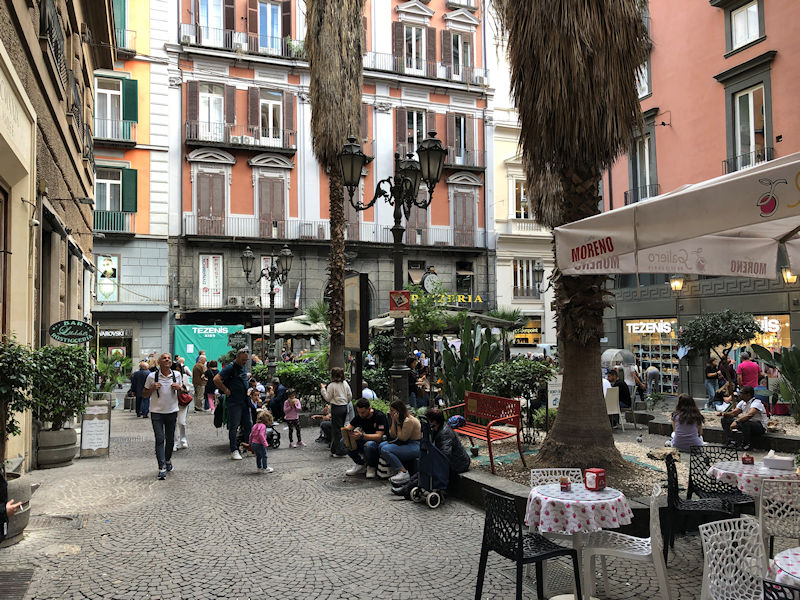
Now the question presents itself -- how to get up to the Castel Sant'Elmo with expiring along the tortuous march up the hill.
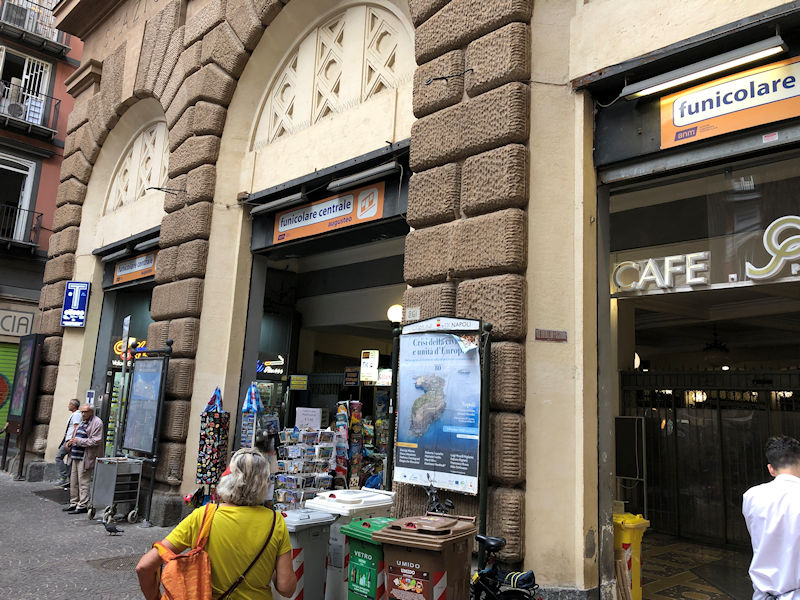
The answer is the Funicolare. There are three funiculars up the Vomero hill, and this is the Centrale, from the Piazzetta Duca d'Aosta on Via Toledo to the Piazza Fuga . . .
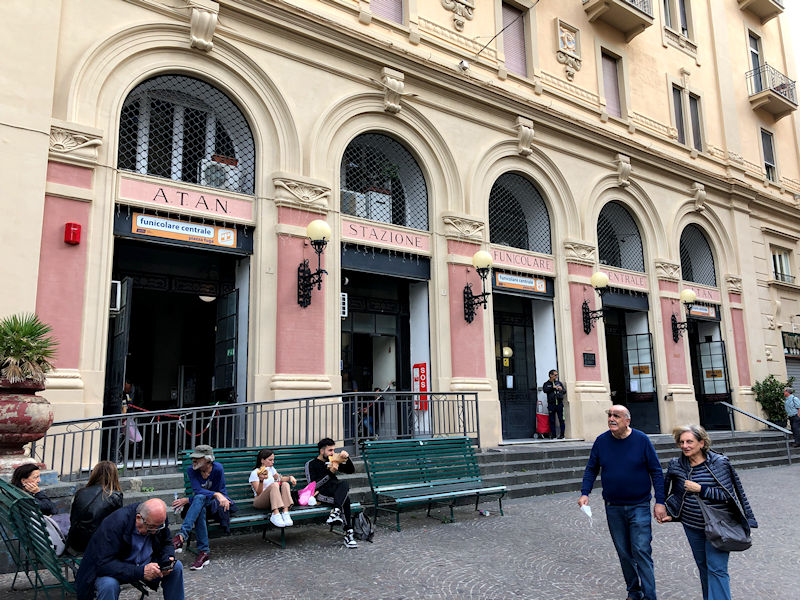
. . . which is only about 500m from the fortress, though the castel entrance is all the way round the other side of it.
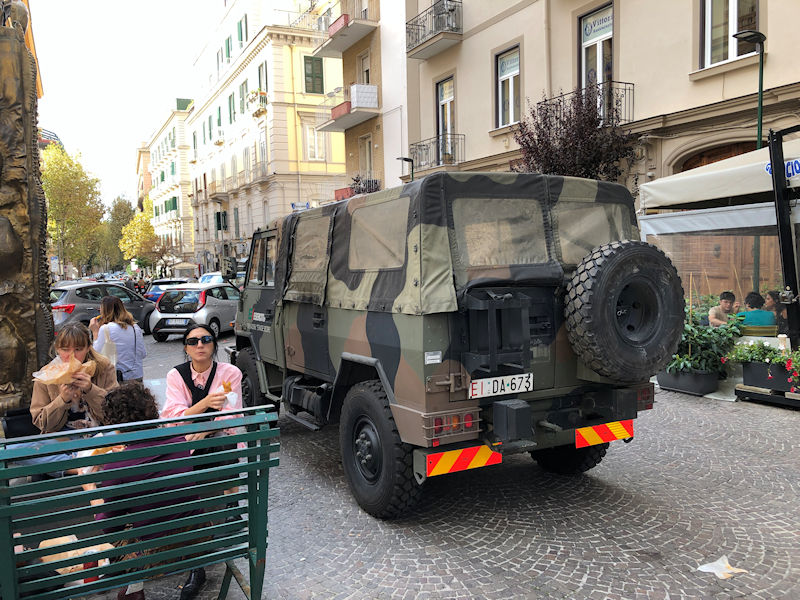
Luckily, no one's in any danger with the Esercito's, the army's, 'Operazione Strade Sicure' on the qui vive. (Apparently they have been making, since 2008, a lot of progress against terrorism and street crime.)
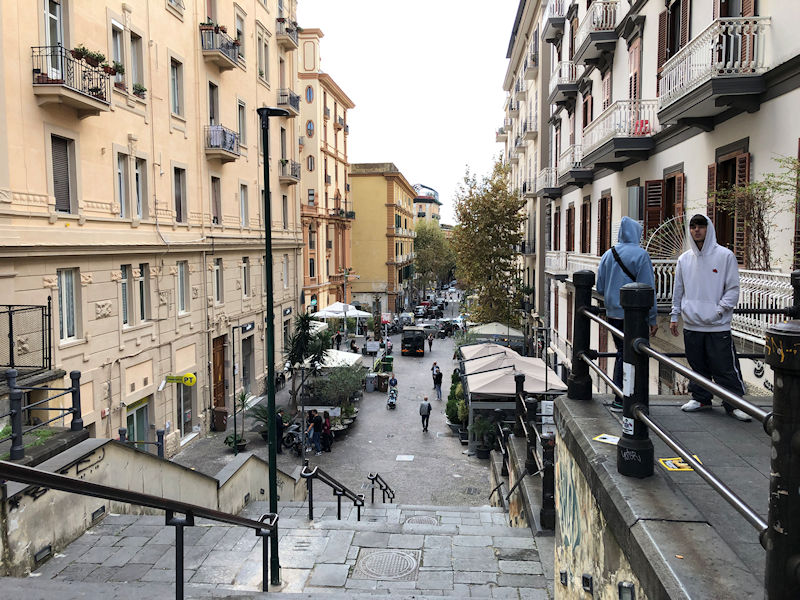
Leaving the army's vigilance behind, we're following signposts for St Elmo and passing lots of probably very nice young people in hoodies.
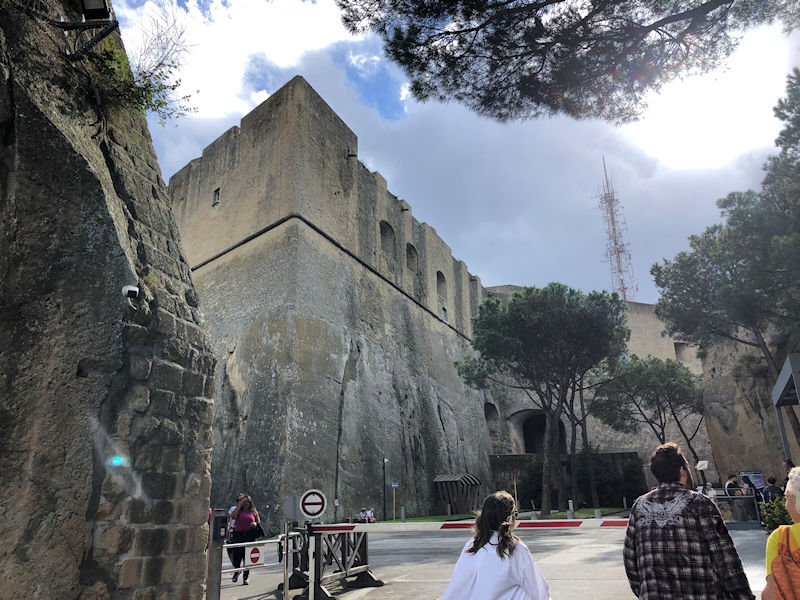
The St Elmo fortress was built beginning in 1275, not long after Charles of Anjou, the brother of St Louis IX, King of France, accepted the papal invitation to oust the last of the Hohenstaufen dynasty from Sicily and southern Italy and thus became King Charles I of Naples (with lots of other titles all over southern Europe) . It was built strategically at the top of the Vomero Hill overlooking Naples on the site of a 10th century church in the name of 'Sant'Erasmo', which evolved over time into Elmo.
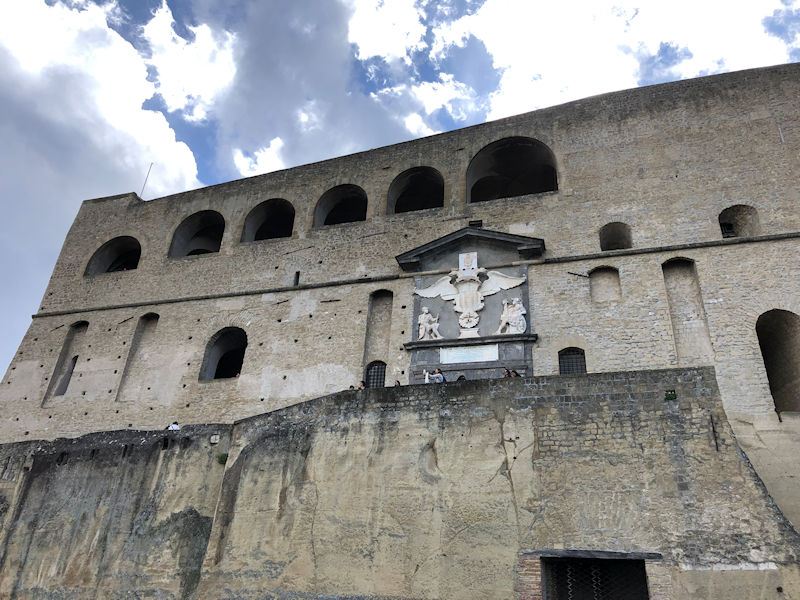
Robert the Wise, who succeeded his grandfather Charles I & then his dad Charles II, significantly enlarged it in 1329 using the designs of a Sienese architect, who also directed the construction of the Carthusian monastery of St Martin immediately below the castle. Much of the castle was badly damaged in an earthquake in 1456, however.
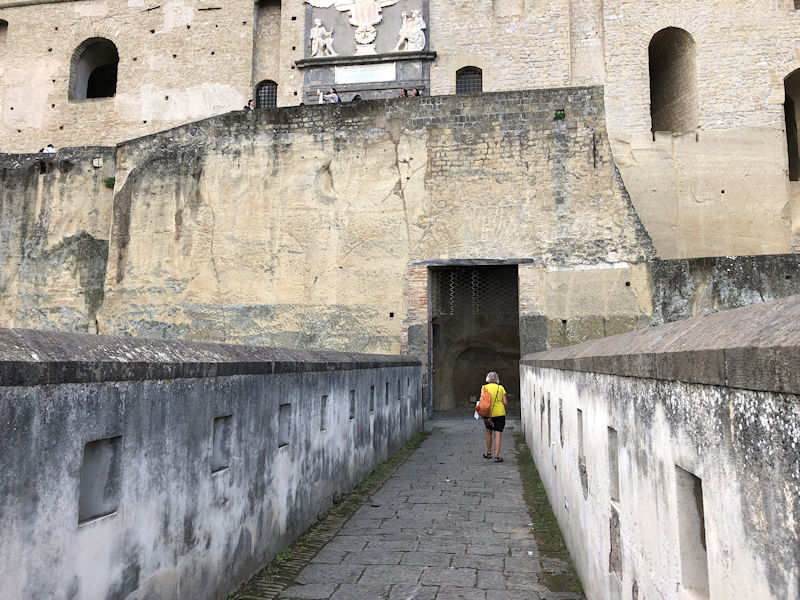
The Spanish Viceroy of Naples from 1532 to 1552 was Pedro Álvarez de Toledo y Zúñiga, who worked hard to improve the land fortifications of the city, perfecting the hexagonal star shape of the fortress between 1537 and 1547, as well as expanding the city walls and fortifying the sea coast roundabout, developing the naval shipyards, building the viceregal palace and dozens of blocks of military barracks for his garrison, a square grid of streets with multi-storied buildings ('unique in Europe for its time') that's still referred to as the Spanish Quarter, executing all petty thieves, and trying to bring the Inquisition in 1547, unsuccessfully.
His boss was Charles V, King of Spain and Holy Roman Emperor, his second cousin in fact, and those are the Emperor's coat of arms and imperial eagle on the wall above.
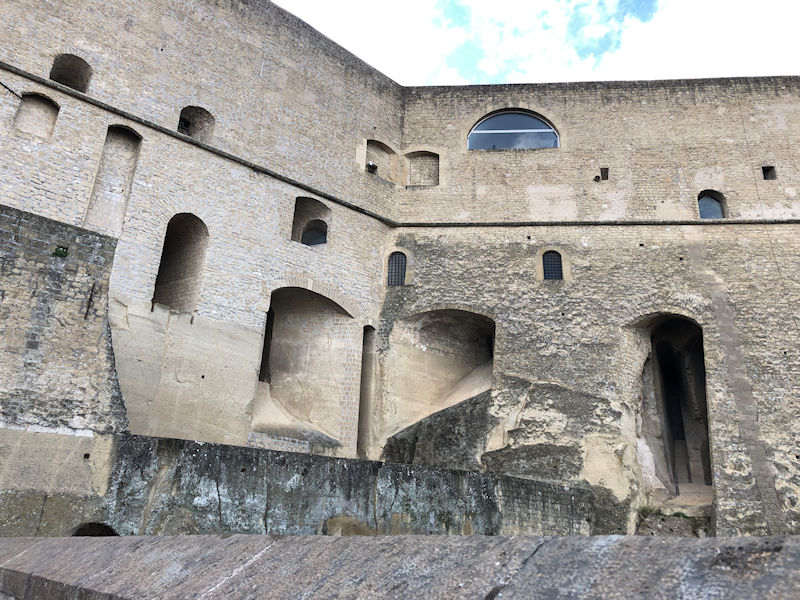
Many of the various loopholes and cannon windows point out over the city below, since that spoke to one of the two purposes of the fortress, to control the city's population as well as to protect it from aggressors.
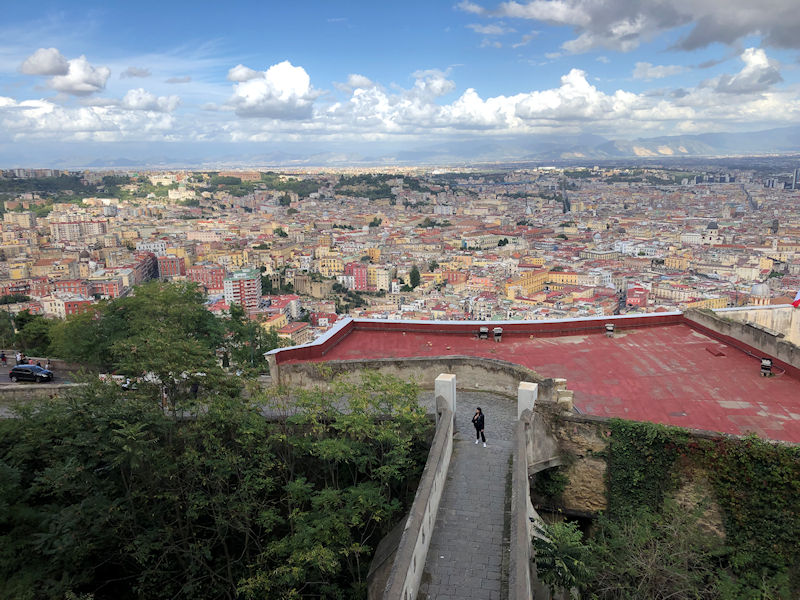
The approach to the upper central block of the fortress is a kind of Krak des Chevaliers affair of winding back and forth, in and out, over a moat, always under the firing positions of the defenders with no cover for yourself.
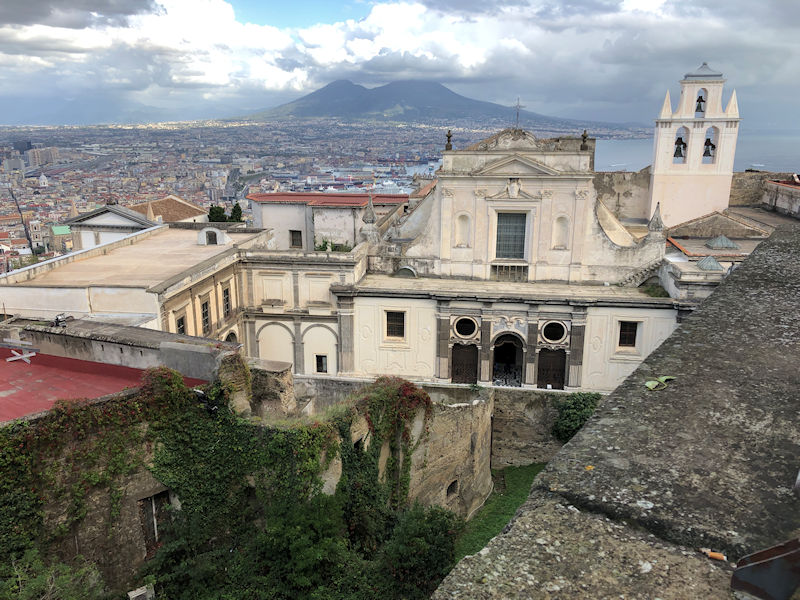
A peek down at the huge Certosa or Charterhouse of St Martin of Tours, a Carthusian monastery inaugurated by Queen Joan I of Naples in 1368, expanded in the first half of the 16th century and again in the 17th, but suppressed by the French occupation in 1799. It was confiscated by the Italian state in 1866 and presently houses the National Museum of San Martino with Spanish and Bourbon era artifacts and a famous presepe or nativity scene.
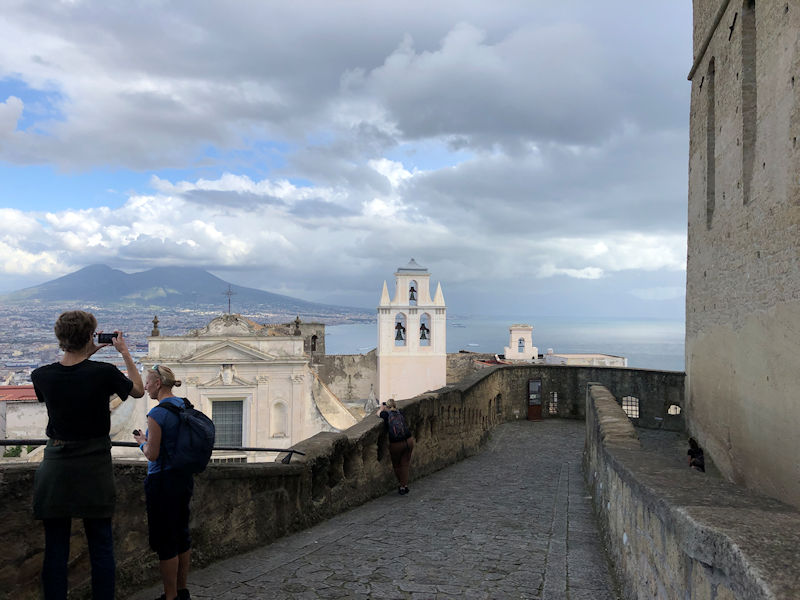
We're still winding up more corridors and ramparts toward the administrative interior.
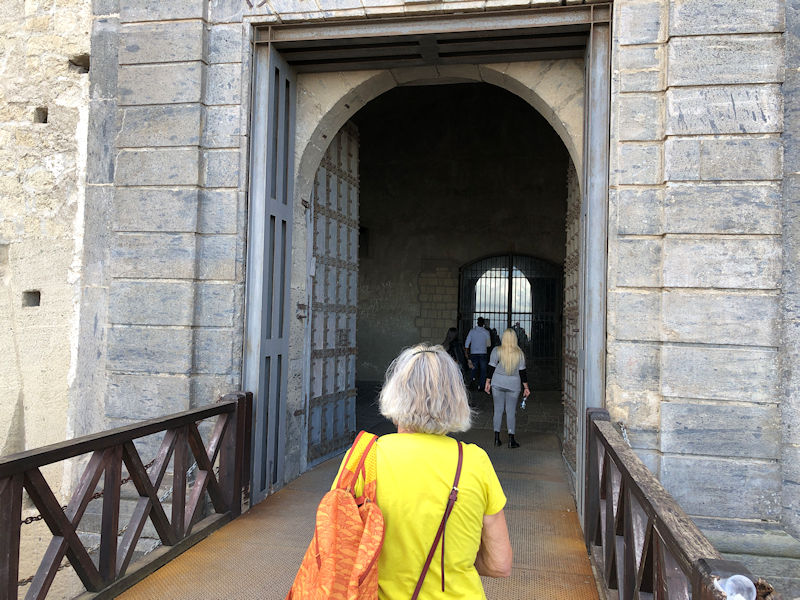
Even the interior corridors have loopholes carefully placed to fire away at any uninvited armed guests trying to run up the hallways.
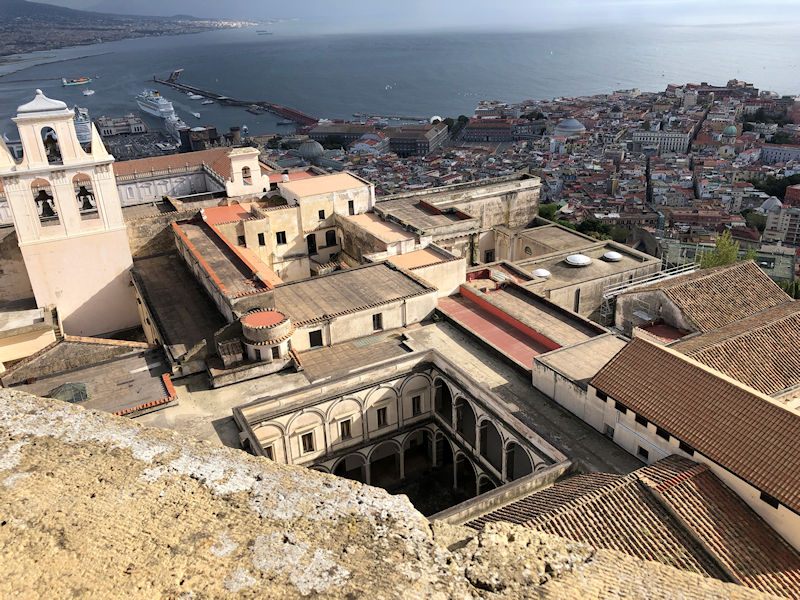
The Certosa overlooking the Bay and port area
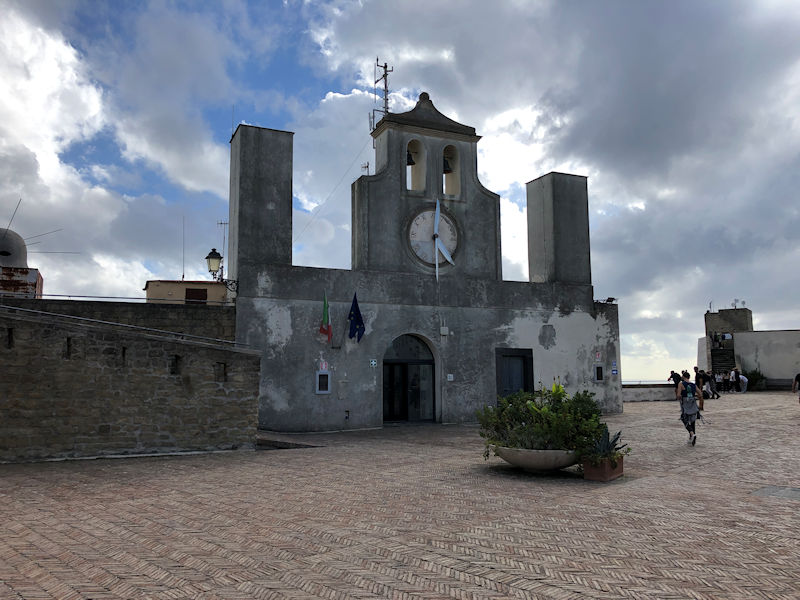
Up on the roof, so to speak, that clock is a humorous addition, with hands that move every which way.
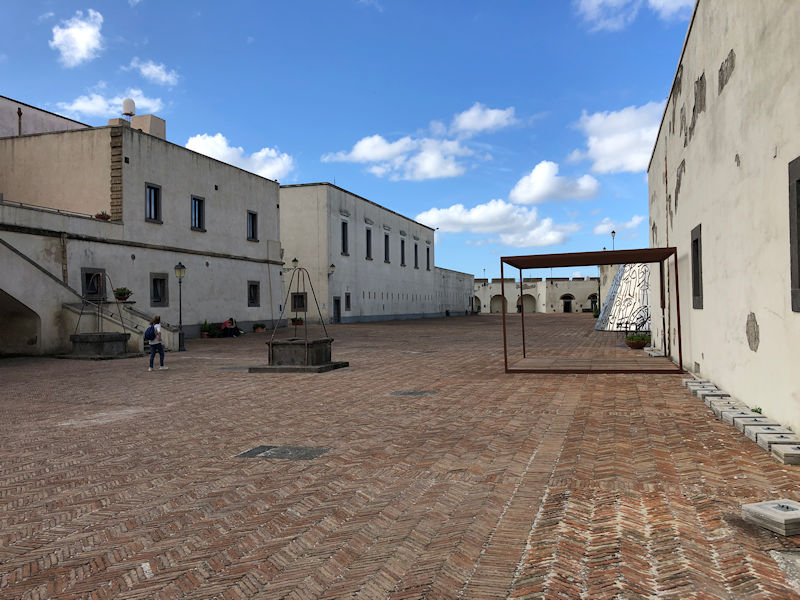
A well that must have been difficult to dig but welcome in the event of a siege (the Fort de Joux, on a main road between France and Switzerland, has a well that was dug 147 metres down). Up here there are administrative offices, barracks, former powder magazines, etc., plus a few minor refinements . . .
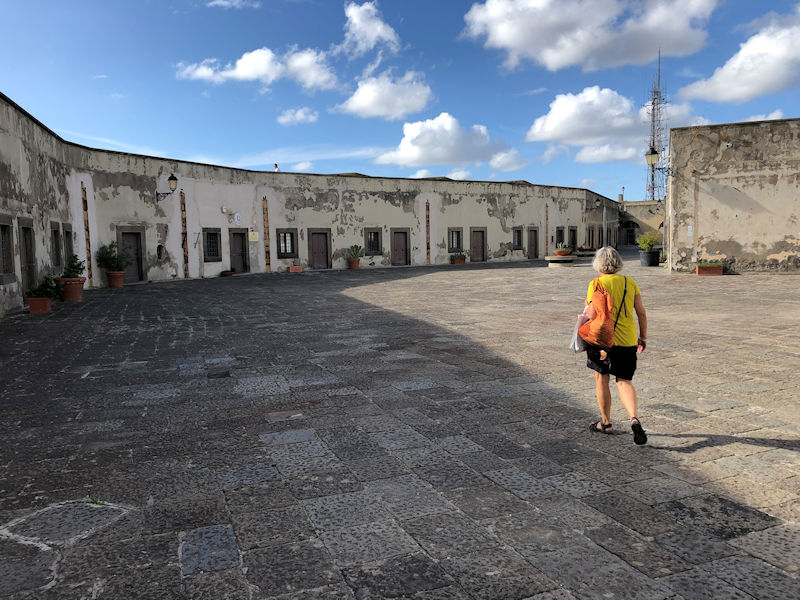
. . . including restrooms, over this way somewhere.
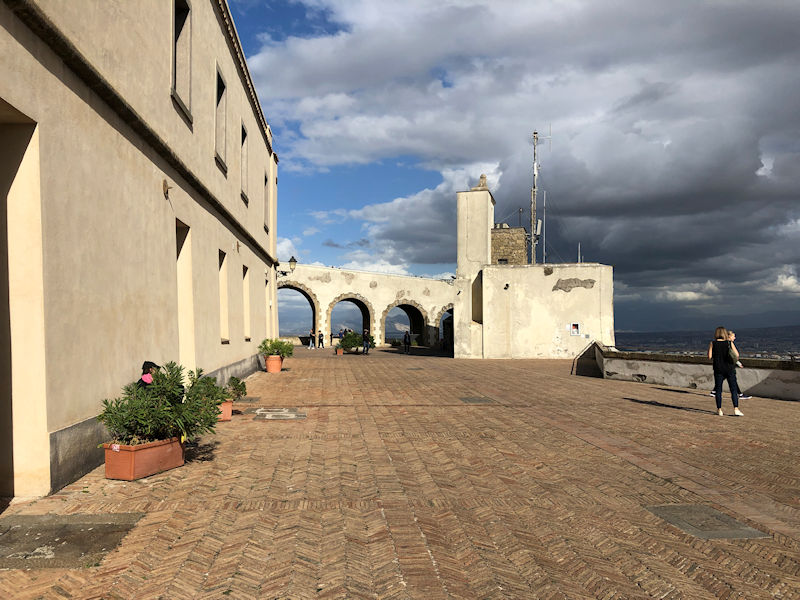
Now to walk the parapets, all the way round. That's the way we came up, so we'll go round the other way for a while.
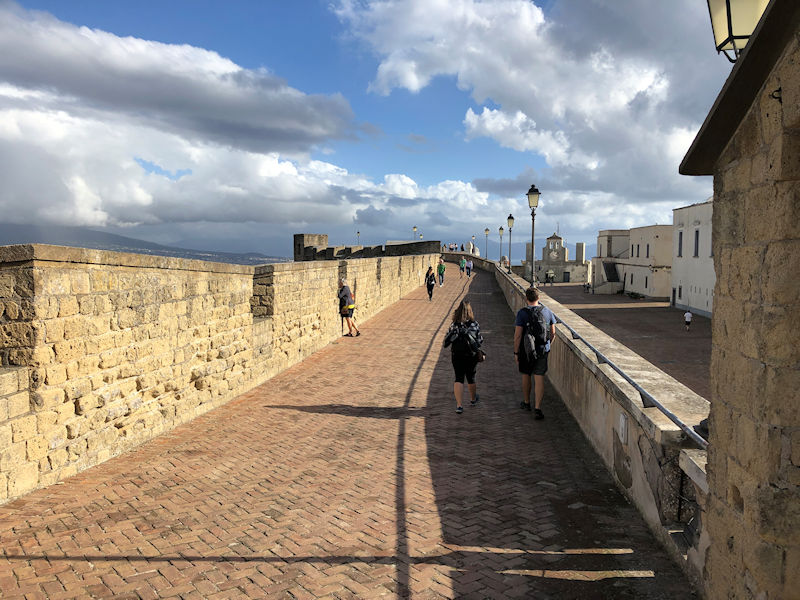
Along the parapets, good for sight-seeing purposes as well as for the exercise
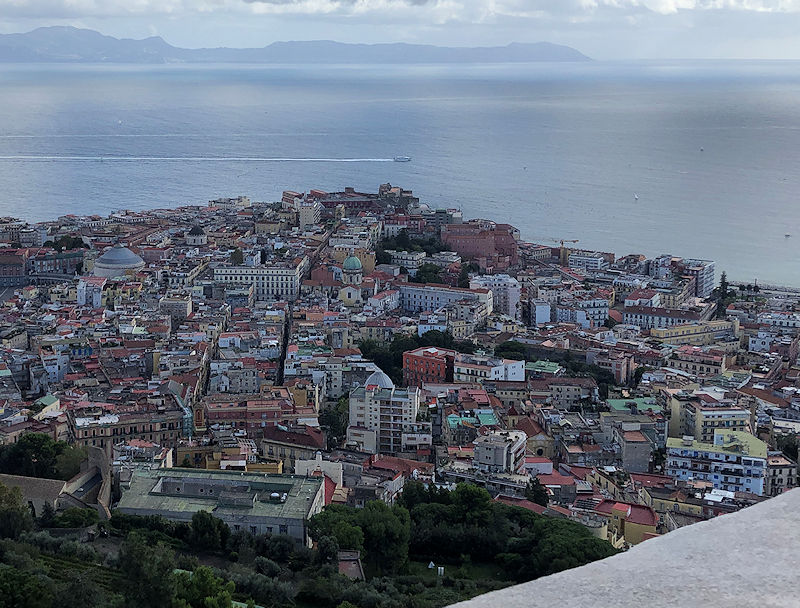
From the ramparts, that's the Castel dell'Ovo on the point (just below the passing ship) -- it's just about a crow-flies mile from here.
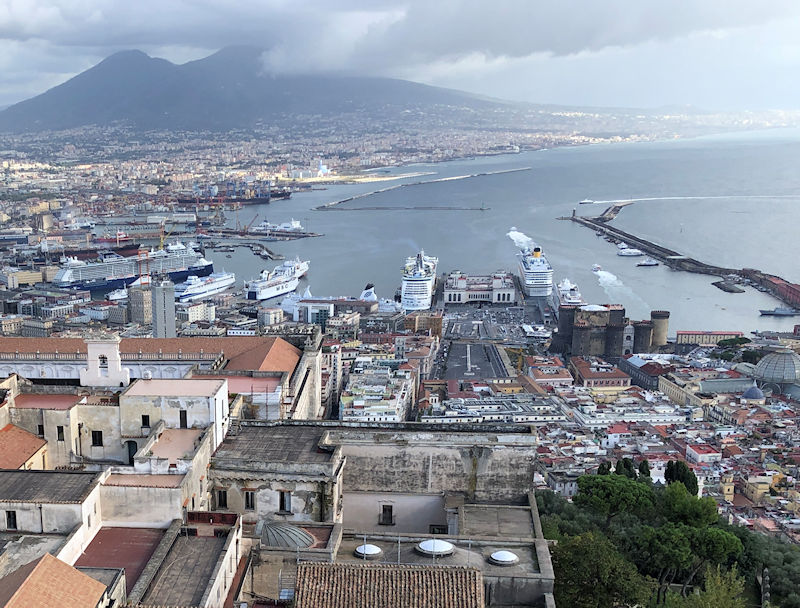
And the commercial port with its (controversial) huge cruise ships, beside the Castel Nuovo
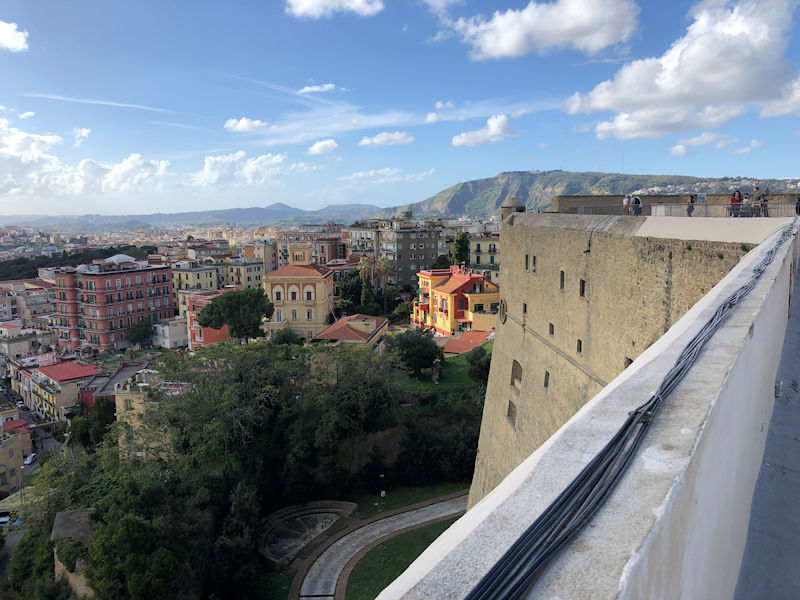
Looking towards the west
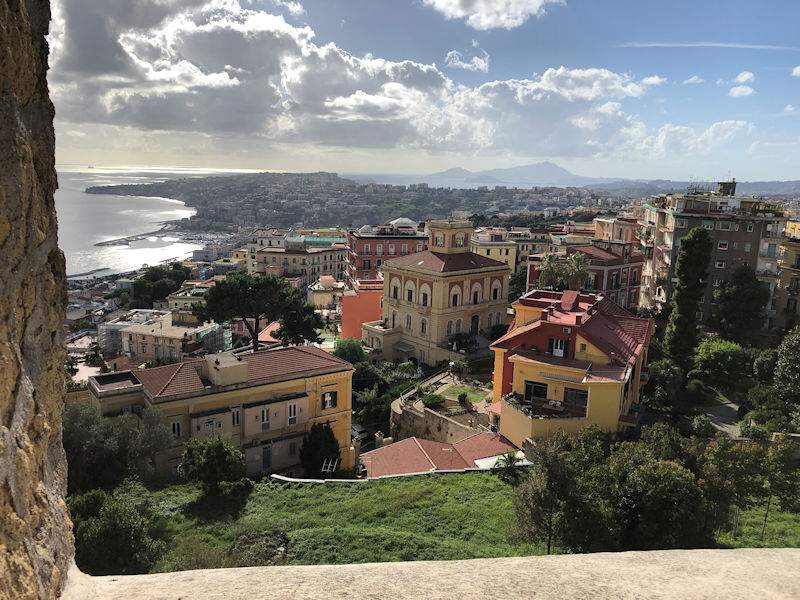
Looking southwest towards the Capo di Posillipo
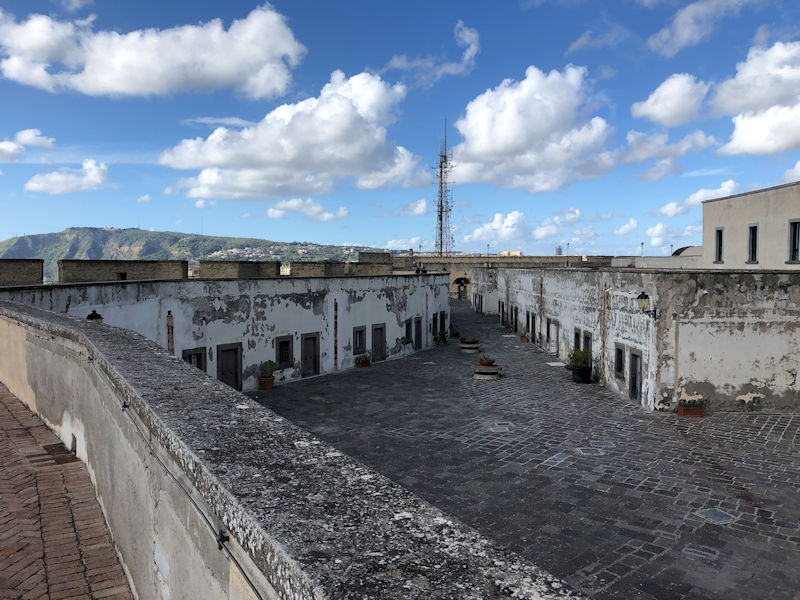
Former barracks, presumably. The present parade ground was reconstructed between 1599 and 1601 after a munitions storehouse was struck by lightning and blew up in 1587. After the Bourbon garrison left in 1860, the castle served as a prison until 1952, but in 1976 it was renovated and devoted to Neapolitan arts and history.
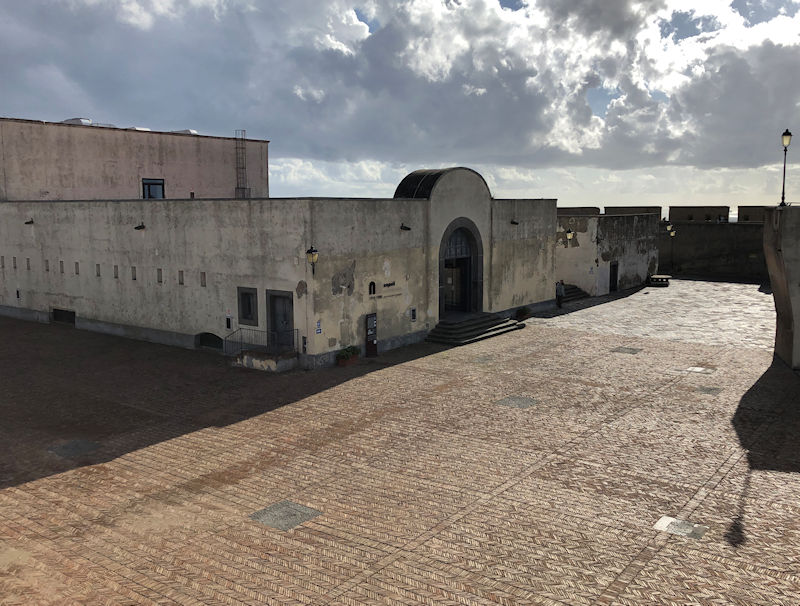
This city-block long Museo del Novecento a Napoli 1910-1980 art gallery was inaugurated in 2010, and . . .
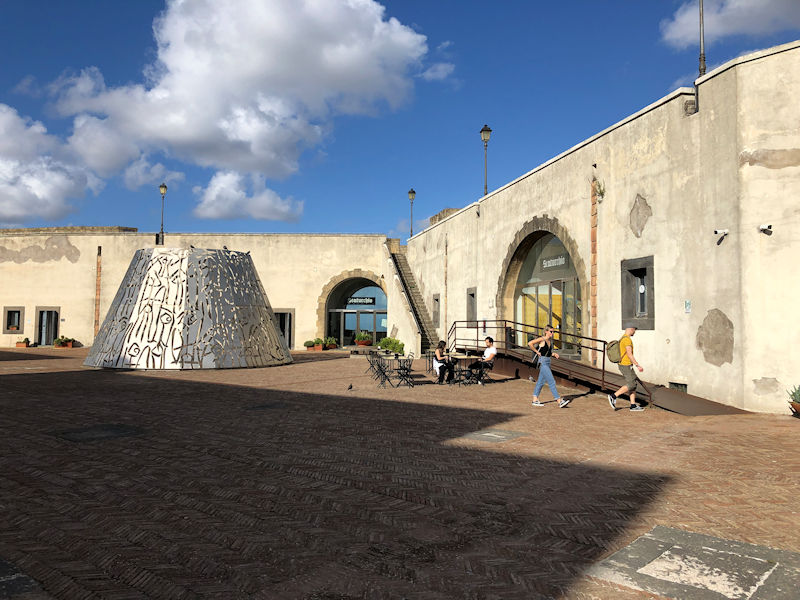
. . . the Scaturchio café on the parade ground appears to be a branch office of the famous Pasticceria Scaturchio down in the centre city.
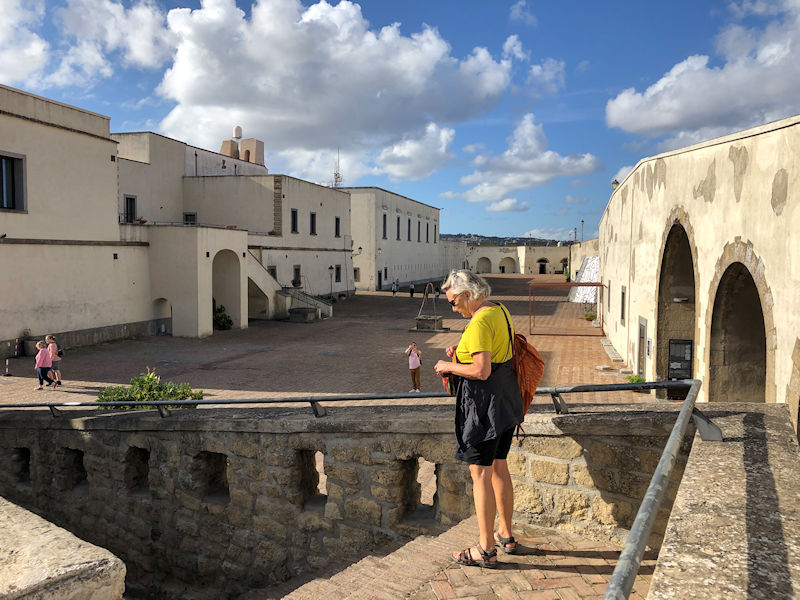
Time to leave, back along the parapet to our exit ramp next to the humorous 'Orologio Castel Sant’Elmo' for getting down with.
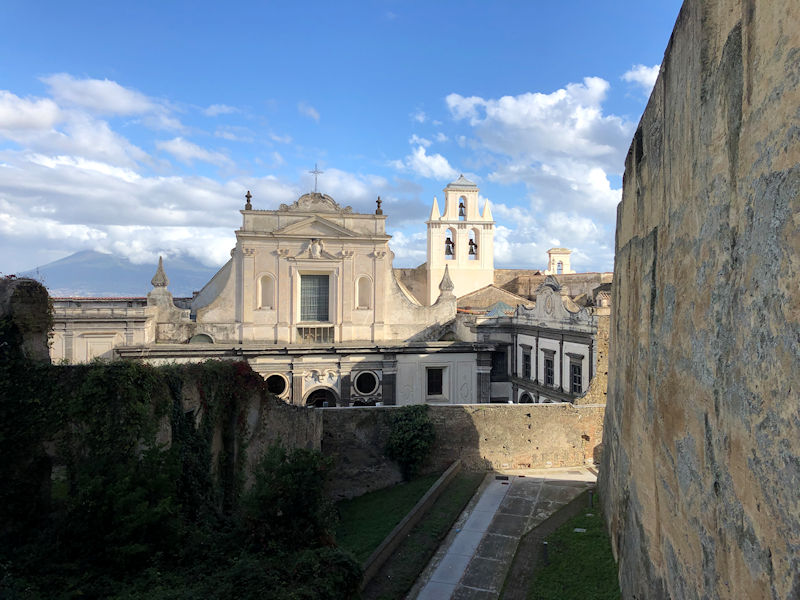
A complicated reticulum of alleys and corridors, fortunately well signposted
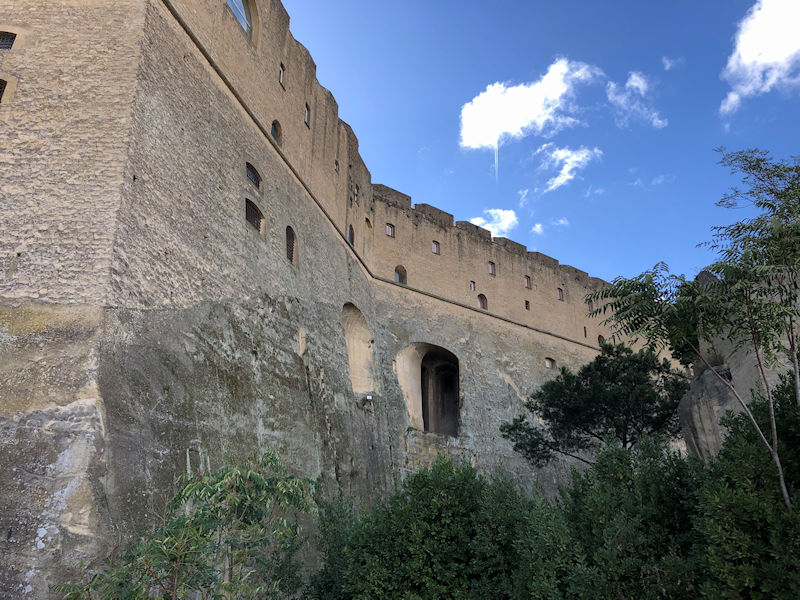
The last time we were here, we opted to walk back down to the city, which is something that we'd rather not go for at present.
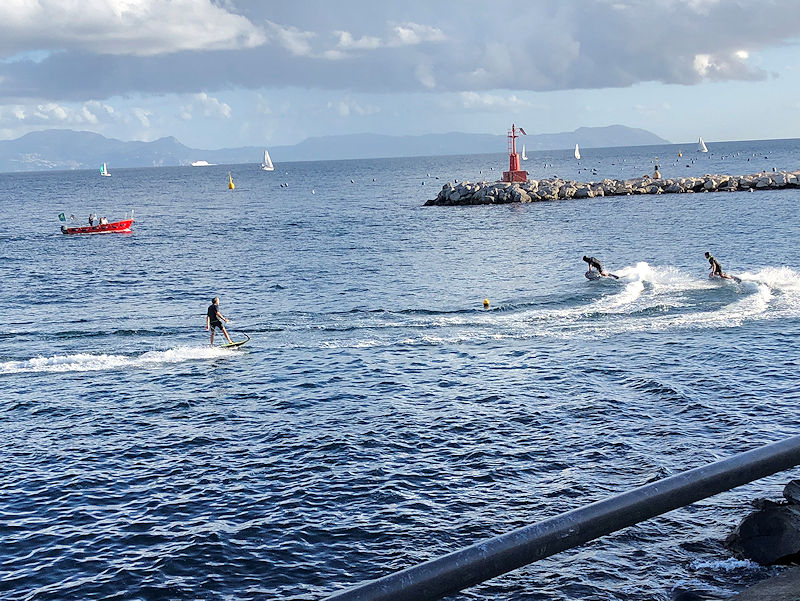
Back down to earth, observing these young people (some with helmets, one without) on some kind of newfangled water toys
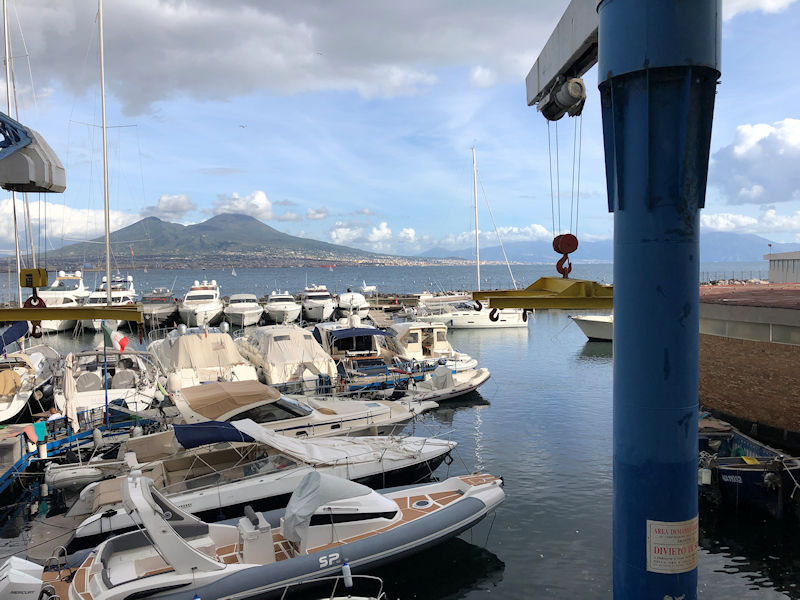
Getting ready for dinner . . .
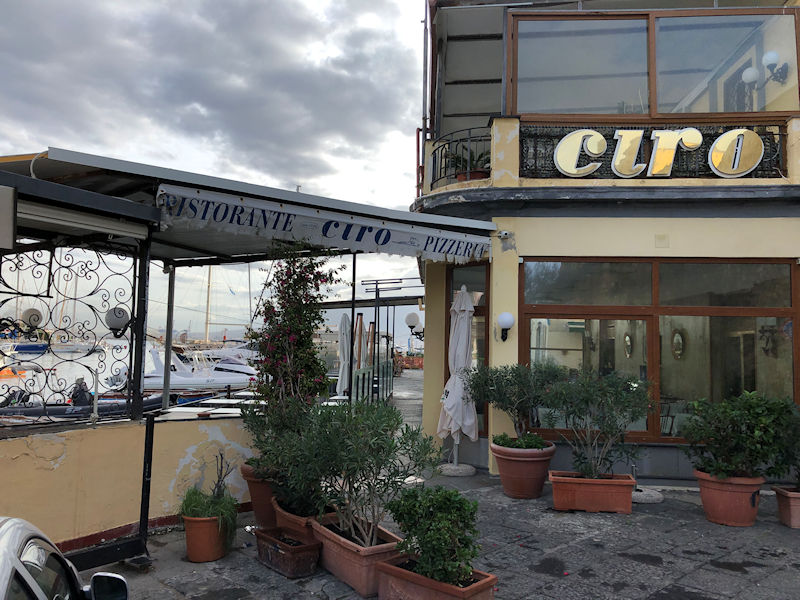
. . . at Ciro. We're suitably early. And this promises to be a two amari night, each.
Next up: The National Archaeological Museum of Naples, part 1


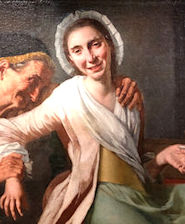 Dwight Peck's personal website
Dwight Peck's personal website














































































